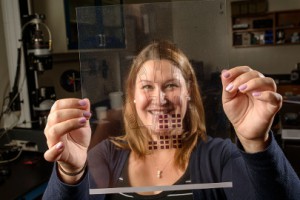CEA-Leti,and its partners have developed three silicon photonics platforms under the four year €10.2 million EU PLAT4M project. Leti’s platform delivers multilevel silicon patterning on 200mm SOI wafers allowing the design of various passive and active devices (such as modulator and photodiode) with thermal tuning capability. Two AlCu levels are available for routing. A PDK is available for circuit design ...
Materials R&D
Research cools solar cells for efficiency boost
Solar cells work more efficiently when they are cooled, but sitting the the sun all day, it is not always easy to achieve this. Researchers at Stanford University in the US have come up with a transparent overlay material that increases efficiency by cooling the cells even in full sunlight. The material works by radiating heat away from the solar cells. ...
Manchester researches 3D printed graphene ink batteries
Batteries could one day be 3D-printed on the desktop using graphene ink, say researchers in Manchester. A government-funded project at Manchester Metropolitan University wants to use the city’s pioneering expertise in graphene technology to develop a desktop printer which will be used to create batteries and supercapacitors that could be used for energy storage in devices from solar power generators to smartphones. ...
Graphene-based film can super cool LEDs
Researchers at Chalmers University of Technology have developed a method for efficiently cooling electronics using graphene-based film. According to the researchers, the graphene film has a thermal conductivity capacity that is four times that of copper. Significantly the team has developed a graphene film that can be attached to silicon substrates. Research team leader Johan Liu, professor at Chalmers University of Technology, ...
Southampton University takes optical fibre research to market
Southampton University, in its Optoelectronics Research Centre (ORC), is making its next-generation optical fibre available for purchase. Until now, access to the technology was limited to commercial or academic collaborations. The new optical fibre will be used in high-power lasers, high bandwidth communications and visible and infrared sensing. The Southampton University research centre is promoting the fibre technology by granting the wider ...
Printed circuits can stretch the wearable boundaries
Electronic circuit boards that are stretchable may soon be used in robots and wearable smart clothing, say researchers at a US-based university. The aim of research at Purdue University is to inkjet-print liquid-metal alloys to create a new type of flexible electronic circuit. Elastic technologies could make possible a new class of pliable robots and stretchable garments that people might ...
Manchester firm bids to commercialise graphene devices
A Manchester-based company is moving graphene devices closer to commercial production using a technique known as chemical vapour deposition (CVD). The spin-out company from the University of Manchester, 2-DTech is producing polycrystalline graphene films, the base substrate for semiconductor devices, with commercially competitive defect density and high mobility. It said it can supply its CVD graphene products in a range of ...
Clothes that generate energy move a step closer
Research is getting closer to creating clothes and shoes which will self-generate energy to power wearable mobile devices. A report in the journal of the American Chemical Society (ACS Nano) describes a foldable nanopatterned material which can use human motion to generate energy. Energy is then stored in a battery or supercapacitor. Researchers in Korea and Australia used wearable triboelectric nanogenerators (TNGs) ...
Imperial researchers target printable graphene
Health sensors could one day be 3D-printed in graphene according to researchers at Imperial College, London. The team at Imperial has developed a method for printing miniature components from graphene, using a new graphene paste. Graphene is the new light and flexible semiconductor material first identified at the University of Manchester. One of the current challenges for engineers is to ...
Will 2015 be the key year for graphene?
Graphene has yet to move out of the research lab, but 2015 could be the year we see the first devices using the “new” semiconductor material. Imec has developed the industry’s first integrated graphene optical electro-absorption modulator (EAM) capable of 10Gbit/s modulation speed with a very low insertion loss and drive voltage. For chip-level optical interconnects, graphene will be used ...
 Electronics Weekly Electronics Design & Components Tech News
Electronics Weekly Electronics Design & Components Tech News









